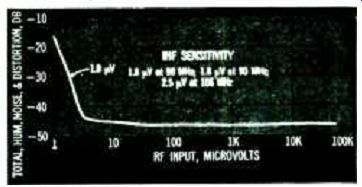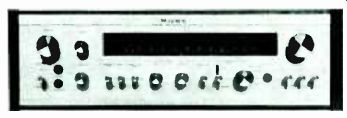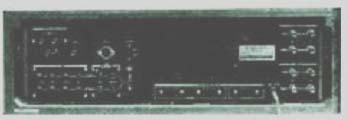
How to explain to your wife why you spent an extra $400 for this stereo receiver.
There's no doubt about it. You can get a fine receiver for as little as $200 or $300. We know, we make them. But we also make a $700 receiver. We know what goes into it. Once you know, you might be compelled to buy one and if you do, you might have to convince your wife about spending $700 for a stereo receiver. So here's what you can tell her.
Point out that the 6120 is actually a bargain. It's sensitive (1.8 microvolts, IHF) so it pulls in stations that other receivers can't. As long as you are paying for the entire FM Band, you might as well get all of it. Prove it by letting her tune up and down the generous 8-inch tuning dial listening to station after station pop out.
Show her how the two tuning meters help locate the strongest signal and the exact center of each channel for best reception.
She understands traffic jams, so tell her about the heavy traffic on today's broadcast bands. Stations are crowded together with little or no separation between them.
Despite this, there's no interference from nearby stations with the 6120 and the one station you want to hear is the only one you'll hear. No other programs or unwanted noises. Adjacent channel selectivity, 100dB.

No wife likes noise. And noise is particularly annoying when combined with music. With the Sony 6120 noise and interference don't intrude upon the music. The 6120 delivers sound as clear and pure as possibly can be expected outside a concert hall. Purer, in fact, for she won't be putting up with audience noises, such as coughing and throat clearing. If she wants proof, mention a few of these specifications: signal-to-noise ratio, 70dB; rejection 90dB; i.f. and spurious image rejection, 100 dB each; and AM rejection 65 dB. Now you can get a bit romantic. Turn on some moody background music, quietly.
She'll relax. Now turn up the volume.
Normally you'll be operating the 6120 at well below one watt. But just so it doesn't have to strain and distort when there's a crescendo passage, it has plenty of power in reserve (rated amplifier power 60 watts per channel into 8 ohms, both channels operating). The 6120 coasts along taking everything in stride from Beethoven to Berlioz, without distortion at any listening level (IM distortion 0.3% at rated output; 0.05% at one watt; harmonic distortion, 0.2 %at rated output; 0.05 %at one watt). You're making progress. Now point out that the 6120 can capture the nuances in the music that are the result of harmonics and other subtleties that make music such a delightful) experience. The 6120 can easily handle the audible sounds with none of the strain and distortion that a narrower band would have to fight. It has more range than you'll ever need, from deepest basso profundo to the highest lyric soprano. The proof: Power bandwidth from 12 Hz to 70 Hz.

Time to begin your closing arguments. Point out all the pleasures of the SONY 6120-FM stereo and FM broadcasts, superb reproduction of records, tapes...only control she'll ever get involved with is the quick-action function selector. In the upper position, the tuner is connected; in the lower position, the record player; in the center, a knob selects microphone, tape head, phone 2, aux 1 and 2. You really don't have to go into detail on the 6120's many other conveniences. But, should your wife ask, you might mention the mode control with 7 positions and switches for low and high filters, loudness contour, tape monitor, FM mode (automatic stereo or stereo only) high blend and muting.
The aux 2 input on the front panel accepts a stereo phono jack. It's useful for making a quick patch in of a tape recorder on playback, or any other high level signal source. For recording there's a front panel line-out jack. There's a headphone jack, speaker selector, treble and bass controls.
The rear panel has inputs corresponding to the front panel selector plus a duplicate set of aux 2 jacks, tape inputs and outputs, and an additional tape recorder receptacle for 5-pin (European type) connections.
A separate mixed left and right channel jack can be used to drive a mono amplifier, or to pipe music into another room. Maybe your wife won't understand the significance of all these conveniences, but she'll know she's getting something extra for her money.

It's time for your wife to audition the 6120. Try plugging a pair of stereo headphones into the front panel jack and mention how compatible the 6120 is. You can enjoy your 6120 while she can enjoy her favorite TV programs in the same room, without interruption.
Next, allay any doubts she might have.
She might feel that while the 6120 sounds beautiful today, how will it sound 3 or 4 years from now? After all, her appliances wear out. Tell her about the "forever filter The SONY solid-state IF filters (there are 8 of them) that preserve the high standard of performance in the 6120 for almost ever, since they cannot go out of alignment Now that you have demonstrated the performance capabilities of the 6120, show her how beautiful it is with oil finish walnut cabinet, brushed aluminum paneling.
Tell her it would take two of the finest components available today to equal the performance of the 6120, and they would cost considerably more. And take up more space, too. Finally, tell her it's Sony, made by those same people who make all of those wonderful things people have come to enjoy in both sight and sound. Now play her favorite musical composition.
You've saved a happy marriage and become the proud owner of a new SONY 6120 FM /FM stereo receiver.
SONY Corporation of America, 47-47 Van Dam Street, Long Island City, N.Y. 11101
SONY--STR-6120
-----------
(High Fidelity)
Also see:
Garrard (ad)
Benjamin--stereo component compact (ad)
Stanton (ad)